Home
Camera
Articles FOR SALE
Orders
I Buy / Wants Repairs
Books Adapters
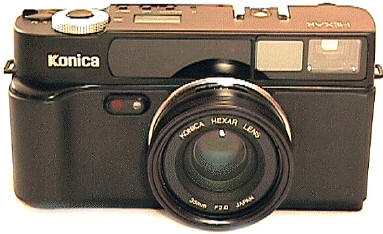
Konica Hexar AF
The Ultimate Available Light Fixed Lens Point
& Shoot
The Konica Hexar AF is a wonderful available light candid
camera, yet deceptively simply and deceptively complex. In some ways
it has no peer, justifying its "cult" camera status as the
ideal stealth street camera. High points include a fast sharp lens
combined with incredibly quiet and fast operation -- quieter and faster in operation than
a Leica M6 !! While some of the
controls are a pain, the Hexar AF occupies a unique place in cameradom: the most
technologically advanced 35mm camera yet made with a fixed 35/2 or faster lens.
The original black Hexar and black Hexar Autodate have "stealth"
film advance mode, probably the quietest motorized film
advance of any 35. On second thought, in silent
mode I can't hear the camera operate -- I have never found a quieter 35mm camera. It
would be great for film sets or courtrooms.
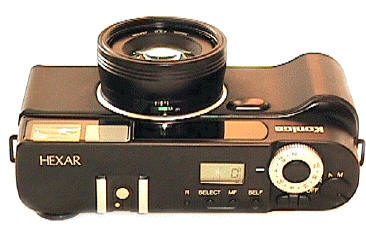
Major Features
- With its autofocus combined with Aperture or Programmed exposure modes, the
Hexar AF offers considerably faster operation than any classic manual focus rangefinder,
including the Leica M series. Active infrared from 2 feet to infinity in 290 steps.
- Fixed sharp 7 element 6 group 35/2 Lens to f/22, 46mm filter. This lens is
reputed to be a near copy of the Leica non-aspheric 35/2 Summicron.
- AE Lock combined with AF lock by slightly depressing shutter release
- Precise fast infrared active autofocus with mostly useless manual over-ride
- Unbelievably quiet film advance in "Silent Mode" aka
"Stealth" film advance
- Programmed, Aperture priority, and match needle exposure
- Shutter Speeds indicated in LCD panel on top of camera
- Non-TTL Metering: 15 degree (EV 0 - 16/ISO 100) or 4 degree
(EV 3 - 18/ISO 100)spot silicon cell metering, notice the centerweighted meter is 3 stops
more sensitive for low light, while the spot meter will respond to two stops higher light
levels, metering cell is on front near traditional self timer location
- Excellent bright viewfinder
- Superb ergonomic shape, very easy to hold with the built in grip
- All models have, or can be upgraded to, AF focusing for
Infrared films -- adjustable for Kodak or Konica IR films. To me personally at least, this is a VERY BIG DEAL since I love
IR films, but not the hassle of manually refocusing the lens each shot.
Damn, I wish ALL AF cameras had this feature.
Details
- Electronic leaf Shutter speed range 30 seconds to 1/250th, plus T
- Flash sync at all speeds for manual or aperture priority exposures.
- Dials and shutter release large and easy to use
- Button controls small and awkward to use
- Quiet motorized film advance with automatic end of roll rewind, also unfinished
roll film rewind
- Silent Mode film advance is extremely quiet, quieter than the legendary Leica M
cameras, but it may not work if battery condition is low
- Close focus .6 meters
- DX film speed setting 25-5000, manual setting 6-6400
- Built in lens shade
- Powered by 2CR5 6 volt lithium battery, good for an estimated 200 24 exposure
rolls
- Auto off in two hours
- All models have, or can be upgraded to, double exposures
- Auto Film Rewind shows film leader near the end on LCD panel, open the camera
back then if you want out of the cartridge film leader
- Manual Rewind before the end of roll by depressing the "R" button with
the tip of a pencil or pen
- Konica made an excellent Hexar case, but it seems to be hard to find on the used
market
- Basic small HX914 dedicated flash, NO TTL flash or
sophisticated flash features -- flash sync at all speeds
- Auto operation 2 to 23 feet with 100 film, guide number 46 in feet with 100 film
- HX914 usable in aperture priority, manual, or programmed modes
- Usable with any flash or flash combination, not limited to on camera flash like
most P/S
- All models have, or can be upgraded to, the extremely useful and accurate Guide
Number flash system . This allows you to get accurate flash exposures with any
flash, so long as you set the correct GN. What happens is the aperture opens or
closes to match the flash output as you focus.
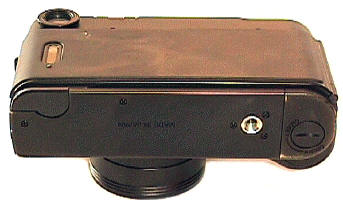
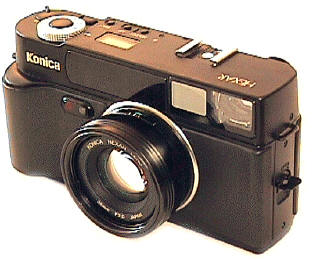
Viewfinder
- Bright and easily seen, even wearing glasses
- Center cross hairs to indicate AF focus point
- Parallax corrected with motorized framelines
- Frame lines easily seen, but not as bright as Leica M framelines
- Green AF focus confirmation LED
- Distance Scale in finder
- Too close focus warning
- Plus/Minus LEDs for match needle and over/under exposure warnings
- NO shutter speeds or f/stop finder display
Manual Over-rides
- Exposure Compensation, plus/minus 2 stops in 1/3 stops
- Manual Focus -- but VERY awkward and time consuming
- AE lock
- Program Biasing -- a very well thought out option
- Manual set ISO possible
Negatives
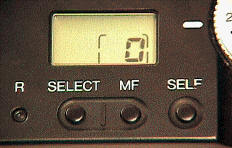 Many functions with the small "Select" and "MF"
buttons are not labeled. If you don't have them memorized, or don't
have an instruction book handy, these effectively secret commands become "The Lost Commands of Hexar." A prime example is
the ever valuable Silent Mode film advance command. Intuitive controls the Hexar is
NOT.
Many functions with the small "Select" and "MF"
buttons are not labeled. If you don't have them memorized, or don't
have an instruction book handy, these effectively secret commands become "The Lost Commands of Hexar." A prime example is
the ever valuable Silent Mode film advance command. Intuitive controls the Hexar is
NOT. -
- Even if you know the controls, the small multi-function "Select" and
"MF" buttons are difficult to work and often confusing. The Hexar AF would
be a MUCH better camera if these were replaced by easier to operate dials.
- A strange thing is that the LCD frame counter disappears whenever you depress
the shutter release slightly: to be replaced by the various camera status readouts.
I've never seen a camera before where the frame counter can disappear -- it can be
a bit irritating if you are near the end of the roll.
- No battery = dead camera
- While the Hexar does have manual focus over-ride, in practical terms it is so
awkward to use it's a waste of time to most photogs
- Meter cell window on camera front in traditional self timer position.
Photog's fingers may obscure meter and IR focusing beam if not careful.
- Top speed 1/250th, this can be a major disadvantage to some shooters. You
can get around this to some extent with a neutral density filter, but you must remember to
manually reset the film speed, since the meter does not read through the filter.
- I would have preferred a more advanced interchangeable data back fitting all
Hexars, instead of a fixed databack on only one model.
- No standard PC connection, but can be used with studio flash via hot shoe/PC
connection adapter, IR transmitter, or slave to on camera flash.
- No cable release of any kind, the only substitute of sorts is the self timer.
- The Hexar's instruction booklet is poorly written, making it difficult to
understand all the camera's functions. If there is a "worst camera instruction
book" award, the Hexar AF may get first prize.
Which Hexar AF is Best for You ?
- 1993 Original Black Hexar: with easy to grip
black rubberized finish, stealth film advance or normal film advance, with NO
databack.
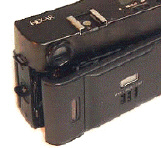 Same camera with databack, the "Autodate" Databack Hexar
pictured to the right: same as above but with bulkier simple date back for day,
month, year, or time, stealth film advance or normal film advance.
The databack original Hexar is rare.
Same camera with databack, the "Autodate" Databack Hexar
pictured to the right: same as above but with bulkier simple date back for day,
month, year, or time, stealth film advance or normal film advance.
The databack original Hexar is rare.
- Many consider the black easy to grip rubberized surface of the first two Hexars
the most usable and least obvious of the Hexar series
- While these Hexars had the very desirable quiet "stealth" film
advance, they did not have four features which Konica will happily still upgrade
them to for only $30: multiple exposures, AF focusing for Infrared Kodak or
Konica films, Guide number focusing flash exposure, and a one button option to quickly
switch to match needle exposure mode with spot metering. If you do have an
original Hexar with the old software, get it updated as soon as you can. Konica
isn't going to keep offering this upgrade forever you know !
- UPDATE: I happened to meet the retired US
Sales Konica sales manager. According to him, the black AutoDate
Hexar AF is actually a very
rare camera. When introduced, no US dealers wanted them. He remembers
only 20 AutoDates being officially imported into the US. He also said that
ONLY the original Hexar and Hexar AutoDate have the completely silent film advance,
contrary to many other sources.
- Rhodium: -- pinkish color -- same specs as upgraded
original Hexar
- Classic: 1993 silver chrome finish Hexars
commemorating the 120th Anniversary of Konica. Hard to find since only 2000 were
made, special gray presentation box, top plate engraved "120 Years, Since
1873." The only Hexar AF with Auto Bracketing! Otherwise, the same
specs as the upgraded Original Hexar.
- Gold Hexar: gold plated Classic commemorating
Konica's 120th Anniversary, only 500 made See Pics
- Silver: 1997 same specs as upgraded Hexar but NO
Silent Mode (wah !!! ) To me, no silent mode means the Silver is the Hexar NOT
to buy. Naturally of course, the Silver is also the only Hexar AF in current
production. Apparently there was some kind of patent infringement, and Konica had to
remove the silence.
Personally I prefer the original Hexar over the
later Hexars:
- I love the super silent "stealth" film advance option.
- The original Hexar is likely to cost less than the later versions on the used
market, though black is often a more popular color. I have no proof of it, but
I also believe more original Hexars were made than the later models, so it will be easier
to find one.
- The original Hexar's black finish is much more in keeping with the stealth
capacity of Silent mode film advance -- at the same time I don't much like the
"flashiness" of the later Hexars
- You can have Konica upgrade the original Hexar to all later Hexar features
except auto-bracketing for only $30
- I don't have much use for the basic data back features offered by the AutoDate
The Lost Commands of Hexar
Many Hexar AF functions are completely inaccessible if
you don't know the secret unlabeled commands. It's kind of like having a secret
password or secret handshake. Woe to you if you buy a used Hexar without an
instruction booklet. Come to think of it, considering how poorly it's written, woe
to you if you buy a used Hexar with an instruction booklet. The guys who designed it
must have had fun hiding the functions with no labels on the controls -- "Oh yeah,
well look at this, I can do even better, they won't be able to figure this one out even if
they have the instruction booklet...HA HA HA HA." This section is not
written to cover all the commands, just the hidden ones that I know of. If you don't
know what the "P, A, or M" on the Hexar's top plate most likely mean, take a
photography class.
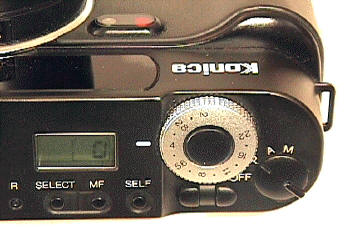
Note the metering and AF sensors in the traditional self timer
position, built in hand grip
- "Stealth" silent film advance: this one
is a real problem, since it is so important, yet COMPLETELY unlabeled on the controls !!
1) Turn the camera off 2) Press the "MF" button and hold it down
3) Turn the camera on to any position 4) Continue holding down the MF button
until a "L" for Low Sound appears on the left side of the LCD panel
5) Release MF button and shoot silently in all exposure modes 6)
Stealth film advance will work on all camera modes, until you turn off the camera,
which unfortunately resets the camera to normal advance.
- SPOT Metering: 4 Degree Spot metering available
ONLY when the camera is in the "M" manual exposure mode. You adjust the
aperture with the large aperture, the shutter speed with the + /- buttons, according to
the red + - LEDs in the viewfinder.
- Infinity Lock: If you have used a screw mount
Leica,
you know about infinity locks. This allows you to lock the lens focus at infinity to
quickly take pics. Most everything will be in focus with this 35mm lens at smaller
apertures. 1) Turn the camera on 2) Press the "MF" button
until you see a "999" in the LCD window. Your camera is now locked on
infinity in all exposure modes 3) It will stay locked on infinity until you
press the "MF" button again to see an "AF" for Autofocus in the
LCD window or you turn off the camera -- which will reset the Hexar to AF when you
turn it back on.
- Lock Focus Distance: 1) focus with AF 2)
Press down shutter release half way 3) Press MF button to lock focus at that
distance -- the distance will be indicated in the LCD panel 4) Focus will stay locked
until you press the "MF" button again, or until you turn off the camera
- Manually Set Film Speed: 1) Turn the camera to
"A" mode 2) Hold down the "Select" button until you see the ISO
film speed in LCD panel 3) Use the unlabeled + / - buttons next to the
aperture dial to select film speed
- Experienced Hexarians will notice not all the secret
commands are listed here. There is a good reason for that, I haven't
successfully deciphered the #@%* instruction book yet !
- Some not too popular Hexar AF features:
- Camera automatically resets from Silent to regular advance
after you turn it off
- Camera automatically resets filter or film compensation
after you turn it off
- Camera automatically resets the film ISO every time
you reload if you are not sticking to the DX film speed rating.
- 1/250th Top Speed
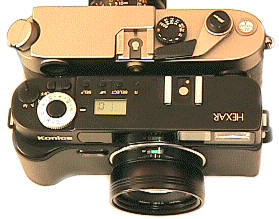
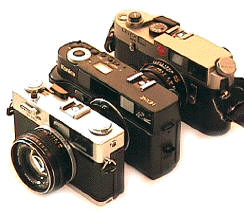
The Hexar's body is about the same size as the M6, though
slightly thicker. On the right, 3 fast lensed available light cameras: Olympus RD,
Hexar, Leica M6.
Oddly Konica has never seemed to do all it can to promote
the Hexar AF -- many experienced photogs have never even heard of it, much less seen
one. Sure, you could special order it from Konica dealers, but
strangely enough I have never seen a new Hexar AF in a camera store --- and I have
seen more than my share of camera stores. As a result any
Hexar AF is not that easy to find, whether new or used.
Though strictly speaking not a
rangefinder camera, the Hexar AF is definitely a modern updated version of the fast
fixed lens rangefinders of the 1970's, such as the Konica S3, Olympus RD and Canon
G-III QL.
Please note I have referred to all autofocus Hexar models as
"Hexar AF" to avoid confusion with the newly introduced "Hexar RF"
interchangeable Leica M mount camera. Konica apparently does not use the "Hexar
AF" terminology.
Revised:
November 25, 2003
. Copyright � 1998-2002
Stephen Gandy. All rights reserved. This means you may NOT
copy and re-use the text or the pictures in ANY other internet or printed
publication of ANY kind. Information in this document is subject to change
without notice. Other products and companies referred to herein are
trademarks or registered trademarks of their respective companies or mark
holders.





 Many functions with the small "Select" and "MF"
buttons are not labeled. If you don't have them memorized, or don't
have an instruction book handy, these effectively secret commands become "The Lost Commands of Hexar." A prime example is
the ever valuable Silent Mode film advance command. Intuitive controls the Hexar is
NOT.
Many functions with the small "Select" and "MF"
buttons are not labeled. If you don't have them memorized, or don't
have an instruction book handy, these effectively secret commands become "The Lost Commands of Hexar." A prime example is
the ever valuable Silent Mode film advance command. Intuitive controls the Hexar is
NOT.  Same camera with databack, the "Autodate" Databack Hexar
pictured to the right: same as above but with bulkier simple date back for day,
month, year, or time, stealth film advance or normal film advance.
The databack original Hexar is rare.
Same camera with databack, the "Autodate" Databack Hexar
pictured to the right: same as above but with bulkier simple date back for day,
month, year, or time, stealth film advance or normal film advance.
The databack original Hexar is rare. 

